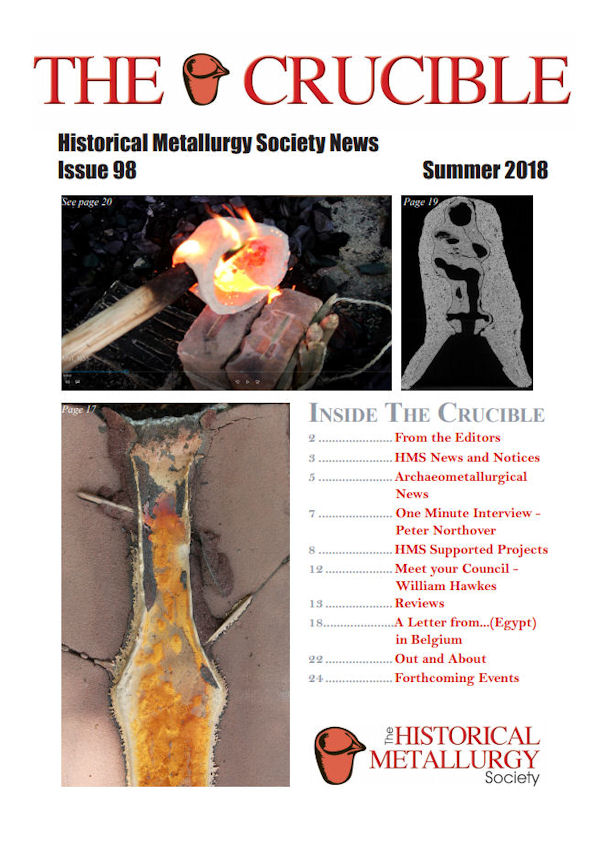Contains: *Fake News? Stoney Hazel Forge. *A placement at the Department of Antiquities of Cyprus. *Metallic traces of past iron industry from La Barthe, France. *Roman gold mining district in Eastern Austria.

The Crucible: Issue 98
Summer 2018
Main contents include…
- Fake News? Stoney Hazel Forge.
- A placement at the Department of Antiquities of Cyprus.
- Detection and conservation of metallic traces of past iron industry from La Barthe, France.
- Research project on a Roman gold mining district in Eastern Austria.
also to be found…
- One Minute Interview – Peter Northover.
- Meet your Council – William Hawkes.
- Obituary for Sam Murphy.
- A Letter from…(Egypt) in Belgium.

Archaeology Datasheet 104
Introduction to post-excavation techniques for metalworking sites
The excavation of archaeological sites often yields a range of material evidence for metalworking. This datasheet is intended to provide an introduction to the post-excavation study of such evidence. The post-excavation process should in most cases be divided into an initial assessment stage which will identify any need for a full analysis stage.
Archaeology Datasheet 103
Geophysical techniques for metalworking sites
Geophysical techniques have become a standard tool in archaeological fieldwork. This datasheet addresses both the recognition of metallurgical features within general surveys and the design of surveys to meet metallurgical purposes.
There is a clear distinction, both in the scale and type of remains, between metalworking on ‘early’ sites and later ‘industrial’ activity. In practice, this means some variation in approach between the examination of ‘greenfield’ and ‘brownfield’ sites.
Archaeology Datasheet 102
Metalworking evidence and archaeological project management
Project management techniques are widely used to plan and monitor the progress of archaeological projects. Project management makes the aims, objectives, methods, timetable, risks and outcomes explicit. It is common to divide a project into a series of stages where the relevant aspects of the project can be reviewed and the project as a whole re-focused if necessary. Archaeological evidence for metallurgical activities is routinely encountered and effective archaeological project management needs to take this into account.
Archaeology Datasheet 101
The archaeology of metalworking sites: an introduction to the field evidence
Evidence for past metalworking survives in the archaeological record in a number of different ways. Many of the larger metalworking sites survive as distinct landscape features due to the construction of structures, as well as the excavation and movement of large volumes of soil and rock. Archaeological excavation frequently recovers features and structures associated with metalworking as well as the associated durable residues and waste materials.
Welcome to WordPress. This is your first post. Edit or delete it, then start writing!
![[Test] The Historical Metallurgy Society](https://test.historicalmetallurgy.org/wp-content/uploads/2020/02/Logo120.png)

